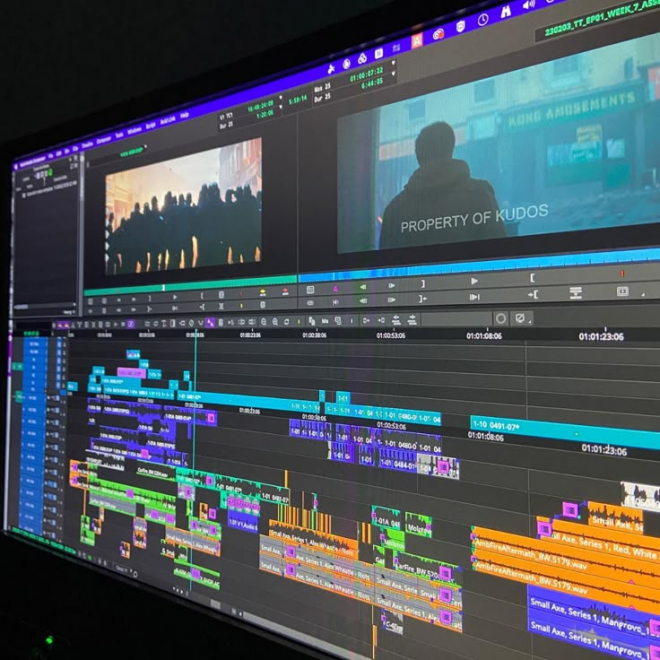Let’s be real: Adobe Premiere Pro is a beast of a program, and if your hardware’s not up to snuff, you’ll feel it—laggy playback, endless rendering waits, maybe even a crash or two. I’ve been there, cursing my old laptop as it choked on a 4K clip. It’s March 15, 2025, and with Premiere’s latest tricks (hello, AI-powered edits!), nailing the right system requirements for Premiere Pro is more crucial than ever for smooth Premiere Pro performance. This isn’t about just meeting the minimums—it’s about building a video editing hardware setup that lets you fly through cuts and effects without breaking a sweat. Ready to make sure your rig’s got the juice? Let’s dig into what you need.
Why does this matter? Because Premiere Pro isn’t some lightweight app—it’s a Creative Cloud system specs hog that demands a beefy CPU for video editing, a solid GPU for Premiere Pro, enough RAM for smooth editing, and speedy storage for video projects. Skimp on any of these, and you’re in for a rough ride. I learned that lesson when my first “budget” PC turned a simple edit into a three-hour ordeal. Let’s break it down so you can dodge that headache and keep your workflow humming.
The CPU: Your Editing Brain
The CPU for video editing is where Premiere Pro does its heavy thinking—decoding footage, applying effects, you name it. Adobe says you need at least an Intel 6th Gen or AMD Ryzen 1000 Series, but for smooth sailing, aim higher. An Intel i7 (9th Gen up) or Ryzen 7 5000 Series is my sweet spot—8 cores minimum. I upgraded to a Ryzen 9 last year, and playback went from choppy to buttery on 4K projects. More cores help with rendering, but clock speed’s king for real-time edits. Check Adobe’s latest (Creative Cloud system specs) for the full scoop.
GPU: The Visual Muscle
Your GPU for Premiere Pro handles the fancy stuff—effects, color grading, and now GPU-accelerated encoding (since 14.2). Minimum’s 2GB VRAM, but don’t settle there—4GB gets you HD, 6GB+ for 4K. NVIDIA’s GeForce RTX 3060 or AMD Radeon RX 6800 are solid picks; I’ve got an RTX 3070, and it chews through Lumetri scopes like candy. Pro tip: keep drivers fresh—my old GPU lagged ‘til I updated. Adobe lists supported cards, but Puget Systems’ benchmarks swear by NVIDIA for Premiere Pro performance.
RAM: The Multitasking Magic
Without enough RAM for smooth editing, Premiere stutters—trust me, I’ve watched it crawl with 8GB on a 1080p timeline. Adobe’s minimum is 8GB, but 16GB is bare-bones for HD, 32GB rocks 4K, and 64GB+ is overkill unless you’re juggling massive projects. I bumped to 32GB last summer, and scrubbing long edits feels like a dream now. Caching eats RAM fast, so don’t skimp—your video editing hardware will thank you.
Storage: Speed Is Everything
Slow storage for video projects is a silent killer—your CPU and GPU can’t shine if footage trickles in. Adobe wants 8GB free for install, but editing needs more. SSDs are non-negotiable—NVMe if you can swing it. I run a 1TB Samsung 970 EVO for apps and cache, plus a 4TB HDD for raw files. Spinning disks alone? Forget it—my old HDD setup lagged like a bad Netflix stream. Aim for 500MB/s read/write minimum; your Premiere Pro performance hinges on it.
The OS and Display Basics
Premiere Pro needs Windows 10 (64-bit, 2004+) or macOS 12 Monterey—older OSes won’t cut it in 2025. Apple Silicon (M1/M2) users, you’re golden with 16GB unified memory for Creative Cloud system specs. Display? 1920×1080 minimum, but I’d grab a 4K monitor—editing on my 27-inch 1440p screen feels cramped sometimes. HDR workflows need DisplayHDR 400, says Adobe, but that’s icing, not cake.
Putting It All Together
Here’s a quick cheat sheet for system requirements for Premiere Pro: Intel i7/Ryzen 7, 32GB RAM, RTX 3060 (6GB VRAM), 1TB NVMe SSD, Windows 11 or macOS Ventura. That’s my current rig, and it’s a dream—4K exports in half the time my old setup took. Don’t have that? Proxy workflows or lowering playback resolution (half or quarter) can save a weaker system. I survived on a 2017 i5 with 16GB for years—tweaking settings was my lifeline.
Why It’s Worth the Effort
Matching your video editing hardware to Premiere’s needs isn’t just about avoiding crashes—it’s about flow. A rig that handles RAM for smooth editing and a fast GPU for Premiere Pro lets you focus on cuts, not curses. My first client edit on a proper setup felt like trading a tricycle for a sports car. Check Adobe’s site (here) or Puget’s tests for the latest—then spec up and edit happy.


